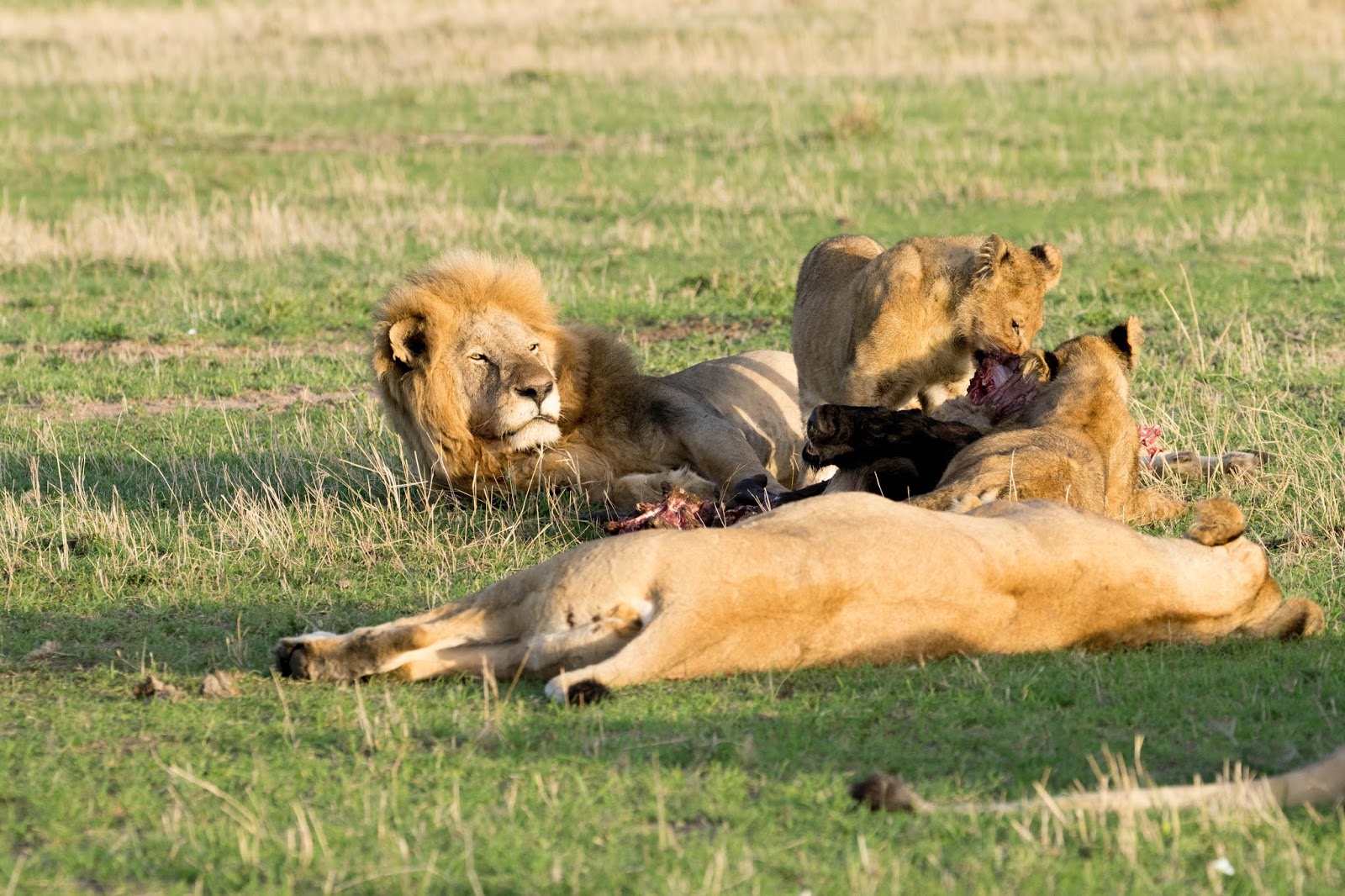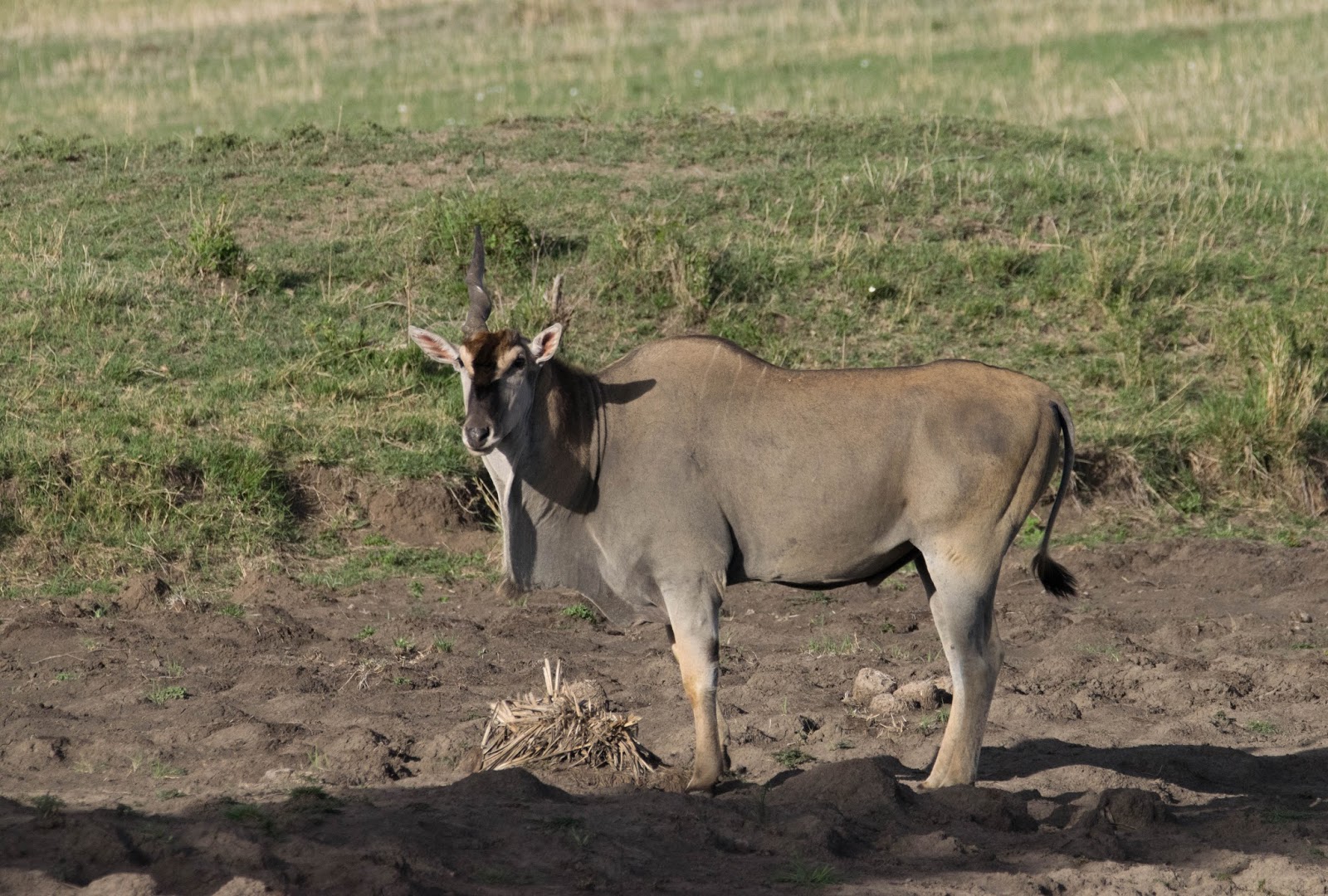Chapter 14
Moving Day on the Masai Mara
If
there were one more thing I could do, it would be to go on safari once again.
—
Karen Blixen (Danish author best known for “Out of Africa”, her account of
living in Kenya)
It’s moving day. We leave Mara Intrepids camp (and all the
bugs that take refuge in my tent during the night*) and take our time getting to
Governor’s Camp, some 22 kilometers away.
By “take our time” I mean several hours.
All the luggage is loaded
into the back of two safari vehicles and we’re off. As we approach a scenic open area, a lion
pride is sacked out around the carcass of a wildebeest. It’s obvious the lions have fed well during
the night and they are now sleeping it off during the golden morning sun.
 |
| Note the small animal directly above the lioness on her back. That is a black-backed jackal waiting for the lions to leave. |
Two cubs chew on the rib
cage, but there isn’t much meat left.
Nearby, at least a dozen
black-backed jackals wait for the lions to leave so they can have a chance at
whatever is left.
Others, not so patiently.
One brave jackal yaps
repeatedly at the lions and decides to just go tell those lions to go away.
The lions pay no attention.
And when we finally go on our way, it’s still a stalemate between sleeping lions and impatient jackals.
A few Grant’s gazelle graze and we draw near the closest one. Flies dot its neck, no doubt seeking warmth in the chilly morning air.
Then we encounter a dik-dik. It becomes apparent almost immediately because the dik-dik is standing still and tolerating our presence.
It also appears anxious, and stares into the trees and bushes that hide a creek bed.
 | |
| Most unusual horns on this one. |
The dik-dik has reason to
be anxious, just by its presence here, but we think there are darker
reasons. This shallow ravine is where
leopards live, and after observing the dik-dik’s behavior, we come to the
conclusion that a leopard might have caught the dik-dik’s mate.
And then we find the vervets. The first one we see is a male who is
sitting on the ground. His bright blue
testicles mark him as the dominant male.
 |
| Yes, yours. |
Another vervet scampers into the open on a nearby tree branch and entertains us with its facial expressions.
Did you know that the collective noun for vervets is a “shrewdness of vervets?” This make absolute sense to me when the vervet begins using sign language to communicate with us.
 |
| It looks shocked. |
 |
| I guess we said somemthing naughty in vervet. |
 |
| Or uproariously funny maybe? |
It gives up on us as being intelligent creatures, and we drive on.
Then Charlie spots a leopard. Jay maneuvers the vehicle back
and forth, but the two leopard cubs are across the creek in thick vegetation.


We never can get a shot of them in the open.
Finally, we give up on
them, and I mention that I’s sure like to see the bird that made that unusual
noise back at Intrepids camp, the Tropical bou bou.
At that moment, one lands
in a tree right in front of the left fender of the Land Rover.
When I’ve finished taking photos of it, I say, “Now I’d like to see a malachite kingfisher.”
Greg and Charlie ask if I can call in birds at will.
It isn’t a malachite, but
a gray headed kingfisher. I don’t
care. Any kingfisher is good.
And then we’re off across
the savannah where herds of gazelle and topis and zebra are grazing.
 |
| This hippo was in a small pool right beside the road. |
We approach a forested
area, turn onto a narrow dirt road, and we have arrived at Governor’s
Camp.
* NO one else had nightly bugs visit their tents. I guess Mary and I were the lucky ones.















































Jeanne, your photos are what one would expect to see in a National Geographic Magazine. You are surely mastering your camera skills.
ReplyDeleteWell ... if I were a black backed jackal, I do not think I would yap at a pride of lions still claiming their kill. Just sayin'. Those secretary birds are TALL!! The dik-dik looks so dainty, almost fragile. However, there probably is not a surviving animal on the African continent that would be considered fragile. The vervet was very entertaining. I could not understand his sign language, but his body language was a hoot. And, just for the record, "I" DO believe you have the ability to call birds at will! Your posts are like being there ... hugs. Patti and Cap
ReplyDelete